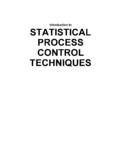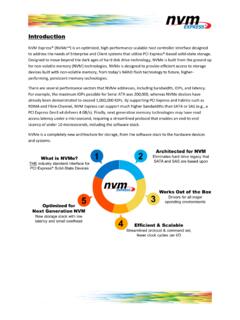Transcription of REDCap Technical Overview Introduction REDCap ...
1 Vanderbilt University | Page 1 REDCap Technical Overview Introduction REDCap is a web application for building and managing online surveys and databases. This document delineates many of the broader Technical aspects of REDCap , such as the infrastructure and third-party software required to host REDCap , details of its data storage model, user privileges, authentication options, logging and audit trails, data interoperability options with other systems, protective security measures, and best practices for hosting REDCap at your local institution. REDCap Infrastructure: Best Practices and Dependencies It must be pointed out that much of the security surrounding REDCap has nothing to do with the REDCap software itself but rather is dependent upon the IT infrastructure and environment in which REDCap has been installed. This includes the web server and database server, the communication between those two servers, and the communication of the web server with the REDCap end-user.
2 Typical best practices are that the web server and database server be two separate servers and that the database server be located securely behind a firewall. The web server may be located either behind the firewall or in the DMZ. Many institutions host REDCap with their web server behind a firewall, but this is often done because it is required by institutional policy. Many institutions (including Vanderbilt University) host their web server in the DMZ so that it is available outside the firewall to the entire internet. SSL is required on the web server in order to maintain secure communication with the end-user, so the web server must be set up with an SSL certificate. With regard to performing data backups for REDCap , most institutions that host REDCap perform a daily (or twice daily) backup of their REDCap database tables, often using mysqldump or other similar software. REDCap has no hard requirements with regard to server processing power, memory, or hard drive space since it is very light weight in most respects and requires very little initial drive space by either the web server or database server.
3 It is typically recommended that 10GB be allotted to the web server and database server each in the beginning. That amount of storage space is typically sufficient for most institutions running REDCap for the first year (or longer), even under heavy usage. It is not always predictable how much drive space will be consumed by REDCap over time since all institutions and users are different, but after several months of solid utilization by day-to-day REDCap users, the amount of space used over time becomes fairly predictable. If the web server is accessible to the web ( in the DMZ), then it is recommended that documents in REDCap not be stored locally on the web server but instead on another server behind a firewall (similar to the database server). Whether you are storing REDCap documents on a typical file server, Network Attached Storage (NAS), or Network File System (NFS), the safest place is behind a firewall using secure communication to REDCap using WebDAV protocol (SSL supported), in which there is an option to enable the WebDAV option in the REDCap Control Center.
4 If the web server is located behind a firewall and not accessible to the web ( not in the DMZ), then it may be perfectly fine to store the REDCap documents on the local web server or on a file system mounted to the web server. Regardless of your setup, you should first consult policies at your institution to see if there are any institutional regulations or mandates with regard to file storage (especially when involving files containing identifying information - PHI) before finalizing your production REDCap environment. Vanderbilt University | Page 2 There is a fairly short list of infrastructure requirements and dependencies for installing REDCap . REDCap can run on a number of different operating systems (Linux, Unix, Windows, Mac). The only requirements that REDCap has are that the hardware and software listed below be installed. (Note: All required software is open source.) REDCap Infrastructure Requirements and Dependencies 1) Web server ( Microsoft IIS or Apache) with PHP or higher (supports PHP 7) 2) Database server with MySQL + or MariaDB + a.
5 MySQL client required for installation/upgrades ( phpMyAdmin, MySQL Workbench) 3) SMTP email server In order to send emails from REDCap , an SMTP server must be configured with PHP on your web server. It can be installed on the same web server or on a separate server (preferred), such as an existing institutional SMTP server, if available. 4) File server (optional) Depending on your infrastructure and setup, you may wish to employ a separate server solely for files uploaded/stored in REDCap . If your web server is accessible to the web ( in the DMZ), it is highly recommended to have a separate file server located behind a firewall that communicates securely to REDCap using WebDAV protocol (SSL supported). Consult your local policy first in case your institution has regulations or mandates regarding this. REDCap User Privileges To ensure that REDCap users have access only to data and information that they are supposed to have access to within the application, user privileges are utilized within the software.
6 Each user has their own account, and their user account will only have access to REDCap projects that they themselves have created or to projects to which other users have granted them access. Some of the general user privileges in the application are dictated by the customizable settings that each institution can adjust, such as whether or not users can create their own projects or if an administrator must create it for them, among other settings. User privileges are also granular on the project level and can be modified within any given project by someone with proper privileges accessing the project s User Rights page. The creator of a project will automatically be given full rights to everything within the project, after which they may grant other users access to the project and limit those users privileges as desired. Within each project, there are user controls to limit access to various functionality and modules, such as being able to export data, to enter data, to add or modify database fields or survey questions, to build or run reports, to modify user privileges, to view the logging records, and so on.
7 Another feature called Data Access Groups can be implemented to help segregate users and the data they enter by placing users into data access groups, after which they will only be able to access records created by someone in their group. This particular feature is entirely optional but is especially helpful in certain situations, such as for multi-institutional projects where the data entered by one institution should not be accessible or viewable by other institutions with access to that same project. REDCap Authentication REDCap implements authentication to validate the identity of end-users that log in to the system. Several authentication methods are available for use in REDCap : LDAP, Shibboleth, OpenID, Google OAuth2, an internal table-based authentication method, as well as a combination of LDAP and table-based together. Institutions running REDCap can choose which authentication method works best for them. The table-based authentication, which utilizes the storage of username/password pairs in a database table, is often the easiest to set up because it is built-in and requires no setup and no configuration with external services in order to operate.
8 For security reasons, the password in the database table is not stored as plain text, but it is first salted and then hashed using a SHA-512 Vanderbilt University | Page 3 cryptographic hash function before being stored in the database table. Also notable is that each user account has its own unique salt value. REDCap contains an auto-logout setting, which is customizable (default auto-logout time is 30 minutes), and will automatically log a user out of the system if they have not had any activity ( clicking, typing, moving the mouse) on their current web page for the set amount of time. This prevents someone else from accessing their account and their project data if they leave a workstation without properly logging out or closing their browser window. There exist some customizable settings that govern login activity, such as being able to manually set the number of failed login attempts before a user is locked out of the system for a specified amount of time.
9 Also available is a user suspension status, which can be set for any given user. Suspending a user allows them to remain a user in the system but denying them access to the entire REDCap application until their suspended status has been revoked. For various reasons, suspending a user is preferable to deleting the user permanently from the system. There also exist some security settings that are specific to table-based authentication. These include allowing users to set their own password and, if desired, prevent them from re-using a recent password. Users can also be automatically forced to change their password after a specified number of days. If using LDAP or Shibboleth authentication, the system can be set to allow any and all users to be able to automatically create their own REDCap account, or conversely it can be set for those users to only be able to access REDCap when an administrator has first added them to a User Whitelist.
10 In this way, the local REDCap administrators get to choose whether they want to be more or less restrictive with regard to how new users gain access to REDCap . Security in relation to authentication can be improved by enabling two-factor authentication in REDCap . Two-factor authentication (sometimes referred to as two-step login) is an optional REDCap setting that can be enabled in the Control Center. Once enabled, two-factor authentication requires the user logging in to perform an additional step in the login process. There are several options available that can be enabled, such as the user having to enter a 6-digit code obtained via email, via SMS text message, or via Google Authenticator app on a mobile device. Another option is to use the Duo app if Duo two-factor authentication is already utilized at the institution. REDCap Logging and Audit Trail REDCap has a built-in audit trail that automatically logs all user activity and logs all pages viewed by every user, including contextual information ( the project or record being accessed).







